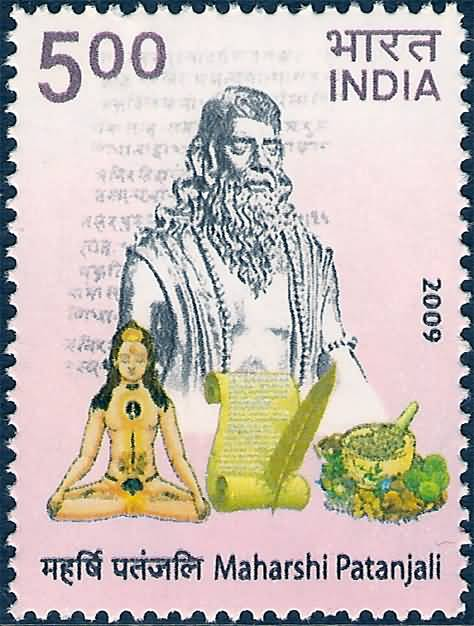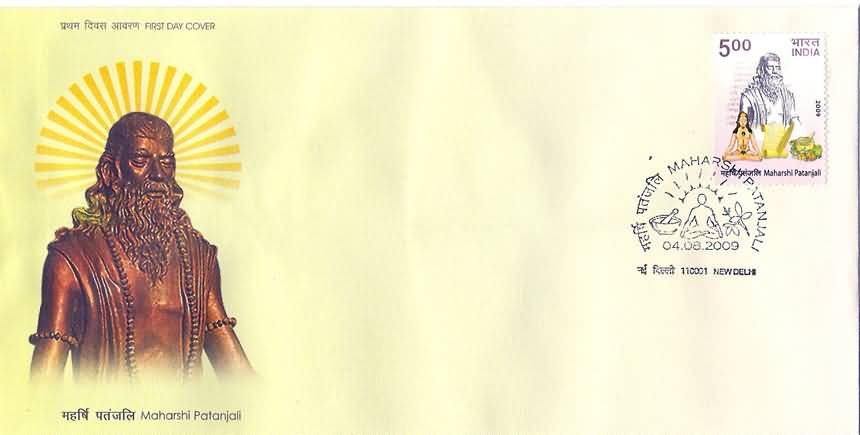Maharshi Patanjali

Technical Data
| Stamp Set | Maharshi Patanjali |
|---|---|
| Date of Issue | August 4, 2009 |
| Denomination | Rs. 5 |
| Quantity | 1,800,000 |
| Perforation | 13 |
| Printer | India Security Press, Nasik |
| Printing Process | Wet Offset |
| Watermark | No Watermark |
| Colors | Multicolor |
| Credit (Designed By) | Smt. Alka Sharma |
| Catalog Codes |
Michel IN 2396 Stamp Number IN 2336 Stanley Gibbons IN 2615 WADP Numbering System - WNS IN049.2009 |
| Themes | Commemoration | Famous people | Feathers | Men | Stationery |
There are six schools of philosophy in Hinduism: Vaisheshika, Nyaya, Sankhya, Yoga, Mimamsa and Vedanta. The earliest exponents of these systems are said to be Kanada, Gotama, Kapila, Patanjali, Jaimini and Vyasa respectively. The exact date of origin of these schools is not known but they are believed to have been formulated prior to the Buddha. The significant features of these schools are: (i) They accept the authority of the Vedas. (ii) These schools do have mutual contradictions on certain issues but they all believed in the Law of Karma, Rebirth and Attainment of Moksha (liberation) as the highest goal of human struggle to achieve realization of the true self.
Patanjali is a revered name, known for his compilation on Yoga Sutras, an important collection of aphorisms on yogic practice. It is believed that Patanjali is an incarnation of Adisesha.
According to a popular legend, Patanjali was born to the first saint of the Saptarishies, Atri and his wife Anusuya. According to this tradition Anusuya had to go through a stern test of her chastity, when the Trinity (Brahma, Vishnu and Shiva) themselves came as mendicants and asked her for alms. She passed their test by accepting them as her children and fed them. She received a boon by which all the three divinities were born to her. It is said that desiring to teach yoga to the world, he fell (pat) from heaven into open palms (anjali) of woman, hence the name Patanjali.
Yoga Sutras are said to be the pioneer in establishing the practice and philosophy of yoga. Yoga in traditionally involves inner contemplation, a rigorous system of meditation practice, ethics, metaphysics, and devotion to God.
The Yoga Sutras codify the royal or best (raja) yoga practices presenting these as an eight-limbed system. The focus is on the mind and yoga defines the cessation of all mental fluctuations and all wandering thoughts so that the mind is focused on a single thought (ekagrata). The eight limbs or the Ashtanga yoga propounded are:
(i) Yama – ethics, restraint and ahimsa,
(ii) Niyama – cleanliness and asceticism,
(iii) Asana – posture,
(iv) Pranayama – breath-control,
(v) Pratyahara – sense-withdrawal,
(vi) Dharana – concentration,
(vii) Dhyana – meditation and
(viii) Samadhi – and oneness with the Pranava of the Ishvara.
Yoga Sutra explains and guides us step by step to the ultimate realization: Moksha (liberation).
Patanjali is also said to be one among the eighteen siddhas. Apart from his inseparable links with the yoga and meditation system, links of Patanjali have also been found with Indian classical dance too. Patanjali’s contribution to the yoga and meditation system has proved to be of great importance and interest not only in India but all over the world.
First Day Cover

